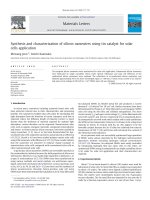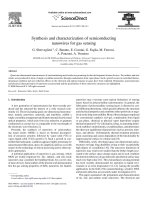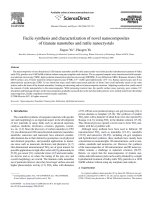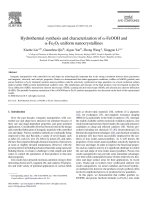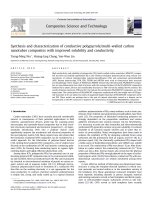- Trang chủ >>
- Khoa Học Tự Nhiên >>
- Vật lý
hydrothermal synthesis and characterization of self - assembled h - wo3
Bạn đang xem bản rút gọn của tài liệu. Xem và tải ngay bản đầy đủ của tài liệu tại đây (1.17 MB, 6 trang )
Journal of Alloys and Compounds 475 (2009) 446–451
Contents lists available at ScienceDirect
Journal of Alloys and Compounds
journal homepage: www.elsevier.com/locate/jallcom
Hydrothermal synthesis and characterization of self-assembled h-WO
3
nanowires/nanorods using EDTA salts
Jang-Hoon Ha, P. Muralidharan, Do Kyung Kim
∗
Department of Materials Science and Engineering, Korea Advanced Institute of Science and Technology (KAIST), 373-1 Guseong-dong, Yuseong-gu,
Daejeon 305-701, Republic of Korea
article info
Article history:
Received 9 May 2008
Received in revised form 9 July 2008
Accepted 10 July 2008
Available online 22 August 2008
Keywords:
Nanostructured materials
Oxide materials
Chemical synthesis
Electrochemical reactions
Transmission electron microscope
abstract
One-dimensional (1D) self-assembled single-crystalline hexagonal tungsten oxide (h-WO
3
) nanostruc-
tures were synthesized by a hydrothermal method at 180
◦
C using sodium tungstate, ethylenedi-
aminetetraacetic (EDTA) salts of sodium or ammonium, and sodium sulfate. Controlled morphological
modification of h-WO
3
nanowire bundles was achieved and hierarchical urchin-like structures were
produced by simply substituting the sodium ions with ammonium ions in the EDTA salt solution. Self-
assembled h-WO
3
nanowire bundles and nanorods that formed urchin-like structures were characterized
by X-ray diffraction (XRD), scanning electron microscopy (SEM), and transmission electron microscopy
(TEM) techniques. 1D self-assembled h-WO
3
nanowire bundles of ∼100 nm diameter and 1–2 m length
were comprised of several individual uniform nanowires of 4–6nm diameter. These individual nanowires
served as building blocks of the bundles. Raman, cyclic voltammetry (CV), and photoluminescence (PL)
spectroscopy studies revealed their structure, electrochemical response, and luminescence properties. The
synthesis of 1D self-assembled h-WO
3
nanowire bundles and urchin-like structures was differentiated by
means of Na
+
- and NH
4
+
-based EDTA salt solutions.
© 2008 Elsevier B.V. All rights reserved.
1. Introduction
One-dimensional (1D) transition metal oxide nanostructures
(nanowires, nanotubes, nanoribbons, and nanofibers) prepared via
self-assembly have attracted considerable interest due to their
high aspect-ratio structure, large surface areas, and unique physical
properties, including optical, magnetic, and electronic characteris-
tics [1,2]. Among the various transition oxides, tungsten oxide has
received wide attention owing to its distinctive photo- and elec-
trochromic properties [3–6]. It is considered a promising material
for a multitude of potential applications including semiconductor
gas sensors, electrode materials for secondary batteries, solar-
energy devices, photocatalysts, erasable optical storage devices,
and field-emission devices [6–11]. In particular, the hexagonal form
of tungsten trioxide (h-WO
3
), is of great interest due to its unique
tunnel structure, and it has been widely used as an intercalation
host to produce tungsten oxide bronzes, by the insertion of elec-
trons and protons or metal ions like Li
+
,Na
+
,K
+
,Zn
2+
, etc. into the
WO
3
structure.
Synthesis of single-crystalline 1D tungsten oxide nanostruc-
tures by heat treatment of tungsten foil, covered by a SiO
2
plate, in
∗
Corresponding author. Tel.: +82 42 8694118; fax: +82 42 8693310.
E-mail address: (D.K. Kim).
an argon atmosphere at 1600
◦
C has been reported [12]. In another
approach, a tungsten tip was electrically etched and then heat
treated at 700
◦
C under argon to yield a 1D nanostructure [13].
Recently, many researchers have attempted to develop methods to
grow pure 1D tungsten oxide nanostructures at low temperature
through solution-based and shape-controlled self-assembly routes.
In the literature [7,14–18], thesynthesis of tungsten oxide nanos-
tructure rods, wires, andbelts hasbeen reported by various reaction
methods, including electrochemical techniques, template directed
synthesis, chemical vapor deposition, solvo- and hydrothermal
reaction, solution-based colloidal approach, and sonochemistry
processes. Among them, solvo- and hydrothermal processes offer
significant advantages, such as total control over their shape and
size, low processing temperature, high homogeneity, cost effec-
tiveness, and easy synthesis. High quality samples can be obtained
by utilizing solvents under high pressures and temperatures to
increase the solubility of the solid and to enhance the rate of
the reaction. Kim and co-workers [14] utilized the solvothermal
process with an alcohol and water mixture to synthesize highly
oriented WO
3
nanowires and bundles. In addition, Gu et al. [15]
reported the synthesis of WO
3
nanowire bundles, urchin-like, and
ribbon-like superstructures based on 1D nanoscale building blocks
by adding different sulfates with oxalic acid under hydrother-
mal conditions. According to their reports, the specific interaction
between the sulfates and the crystal surfaces in presence of oxalic
0925-8388/$ – see front matter © 2008 Elsevier B.V. All rights reserved.
doi:10.1016/j.jallcom.2008.07.048
J H. Ha et al. / Journal of Alloys and Compounds 475 (2009) 446–451 447
acid has played a vital role to produce hierarchical structures of
1D WO
3
nanocrystals. Recently, ethylenediaminetetraacetic (EDTA)
has been effectively employed in the hydrothermal process as a
chelating ligand and capping reagent to produce 1D nanostruc-
tures of ␣-Bi
2
O
3
, YVO
4
, CeVO
4
, and LaVO
4
:Eu
3+
rods [19–22].As
a result, the importance of EDTA as a structure-directing agent
under hydrothermal conditions has focused our interest to utilize
EDTA inthe synthesisof 1D h-WO
3
nanocrystals with different mor-
phologies. Therefore, the present work investigates the synthesis of
1D self-assembled h-WO
3
nanocrystals using sodium and ammo-
nium ions based EDTA salt solutions. Also, it is intended to identify
the experimental parameters that control the morphology of WO
3
nanowire and/or urchin-like structures.
In this paper, the authors report on the synthesis of 1D h-
WO
3
nanostructure using EDTA salt solutions and sodium sulfate
through a simple hydrothermal process. The processfacilitates con-
trol over the shapes of nanowire bundles and nanorods, allowing
the formation of urchin-like crystalline h-WO
3
via simple substitu-
tion of NH
4
+
in place of Na
+
ions of EDTA salt solutions.
2. Experimental procedure
The analytical grade precursor chemicals used were sodium tungstate
dihydrate (Na
2
WO
4
·2H
2
O, 99% Aldrich), ethylenediaminetetraacetic acid
((HOOCCH
2
)
2
NCH
2
–CH
2
N(CH
2
COOH)
2
, Junsei), sodium hydroxide (NaOH, Shinyo),
ammonium hydroxide solution (NH
4
OH, 25%, Fluka), sodium sulfate (Na
2
SO
4
),
hydrochloric acid (HCl), and deionized (DI) water. All chemicals were used without
further purification.
In a typical procedure to prepare the h-WO
3
nanorods, 1.84 g (0.0055 mol)
Na
2
WO
4
·2H
2
O was dissolved in 10 mL of DI water under stirring. The clear solution
was slowly acidified to a pH range of 1–1.2 using 10mL of 3 M HCl under continuous
stirring to form a pale yellow precipitate. EDTA salt solution was prepared by dis-
solving EDTA and sodium hydroxide in 50 mL of DI water under continuous stirring.
Subsequently, the clear EDTA sodium salt solution was added to the tungsten acid
precipitated solution and diluted to 80mL, and a specified amount of sodium sulfate
(1.25–5 g) was added. 80 mL of the mixed slurry solution was transferred to a 100-
mL Teflon-lined stainless steel autoclave and hydrothermal reaction proceeded at
140–180
◦
C for 4–12 h in a preheated electric oven. After the reaction, the final prod-
ucts were washed sequentially with DI water and ethanol to remove the sulfate ions
and other remnants by centrifugation. Theobtained powder was subsequently dried
at 60
◦
C for 12 h in air. In the above procedure, NH
4
OH was added instead of NaOH to
form an ammonium-based EDTA salt solution and an excess amount (i.e. 20mL) of
3 M HCl was added to maintain the pH in a range of 1–1.2. The other conditions were
held unchanged to prepare self-assembled nanorods that form urchin-like h-WO
3
nanostructures.
The synthesized h-WO
3
nanostructures were characterized using an X-ray
diffractometer (XRD, Rigaku, D/max-IIIC X-ray diffractometer, Tokyo, Japan) withCu
K␣ radiation ( = 0.15406 nm at 40 kV and45mA).The sizes and shapes of thenanos-
tructures were observed on a field emission scanning electron microscope (FE-SEM
Philips XL30 FEG, Eindhoven, Netherland), a high-resolution transmission electron
microscope (HR-TEM, JEM 3010, JEOL, Tokyo, Japan),andmicro-Raman spectroscopy
(LABRAM, Jobin-Yvon, France) using a 514.5 nm—line Ar ion laser in a backscatter-
ing geometry, where the laser power at the sample location was set at 1 mW. Cyclic
voltammetry (CV) was performed in a classical three electrode electrochemical cell
within ±0.8 V for WO
3
film deposited on an ITO-coated glass substrate, by dipping
the ITO-coated glass into a highly dispersed nanostructured h-WO
3
in DI water.
A single-compartment cell was configured with three electrodes: an h-WO
3
layer
on an ITO-coated glass substrate acted as a working electrode, a platinum wire was
used as an auxiliary electrode, and an Ag/AgCl was used as a reference electrode and
the electrolyte was 0.1M H
2
SO
4
. The fabricated electrochemical cell was connected
to a potentiostat/galvanostat (Princeton Applied Research 263A, TN, USA) con-
trolled by a computer program. The photoluminescence (PL) spectra were recorded
for the h-WO
3
nanostructures using a photoluminescence spectrometer (PS-PLUI-
XWP1400, Seoul, Korea) equipped with a 500-W Xe arc-lamp under excitation at
275 nm.
3. Results and discussion
Nanowire bundles and urchin-like structure crystalline h-
WO
3
samples were synthesized through hydrothermal reaction of
Na
2
WO
4
·2H
2
O, HCl and Na
+
-orNH
4
+
-based EDTA salt solutions in
the presence of Na
2
SO
4
. The XRD patterns for the as-synthesized
h-WO
3
powders using Na
+
ion- and NH
4
+
ion-based EDTA salt
Fig. 1. XRD patterns of h-WO
3
nanopowders: (a) nanowire bundles (Na
+
-based
EDTA), (b) urchin-like (NH
4
+
-based EDTA) and (c) JCPDS card # 33-1387, hydrother-
mally synthesized at 180
◦
C for 8 h.
solutions are shown in Fig. 1. For the as-synthesized h-WO
3
with
Na
+
-based EDTA, intense and sharp diffraction peaks (Fig. 1a)
are observed, indicative of high-degree crystallinity. On the other
hand, the as-synthesized h-WO
3
with the NH
4
+
-based EDTA sam-
ple showed broader peaks with less intensity (Fig. 1b). It is also
observed that there are no other impurity phase peaks. The diffrac-
tion peaks can be indexed to the pure hexagonal phase of WO
3
with lattice constants of a = 7.2614Å and c =3.859 Å, which agrees
well with the reported values of a =7.298Å,c =3.899 Å, space group
P6/mm from the JCPDS card # 33-1387, as shown in Fig. 1.
SEM micrographs presented in Fig. 2 show the as-synthesized h-
WO
3
utilizing Na
+
ion- and NH
4
+
ion-based EDTA salt solutions via
the hydrothermal method at 180
◦
C for 4 h and 8 h, respectively. It
is observed in Fig. 2b that the self-assembled nanowires formed
nanowire bundles as a result of the synthesis approach using
Na
+
-based EDTA salt solution. Alternatively, numerous nanorods
were self-assembled to form an urchin-like microspherical (Fig. 2e)
structure by the addition of NH
4
+
-based EDTA in place of Na
+
-based
EDTA, while theother conditionswere maintained the same. Highly
oriented 1D nanowires were self-assembled to form nanowire
bundles of h-WO
3
having a diameter of 100–150 nm and length
of 1.5–2.5 m, with individual nanowires of ∼4–6 nm diameter
(Fig. 2b). It is observed in Fig. 2b that the single-crystalline 1D
h-WO
3
nanowire bundles with a flat tip end had formed after reac-
tion for 8h. The low magnification SEM image in Fig. 2c shows the
large area distribution of uniform nanowire bundles. Urchin-like
microspherestructures (Fig. 2e)∼2 min diameter were formedby
self-assembly of numerous nanorods. The surfaces of these micro-
sphere structures were covered by numerous nanorods such that
they take on the appearance of urchin-like structures, and the com-
posed individual nanorods measured ∼5–20 nm in diameter. The
energy dispersive X-ray (EDX) spectrum presented in Fig. 2f reveals
a 3:1 molar ratio for oxygen and tungsten elements, which solely
constitute the composition of the h-WO
3
nanorods/nanowires.
In order to elucidate the h-WO
3
self-assembled nanostructure
growth process, hydrothermal experiments were carried out under
various reaction conditions. The SEM image (Fig. 2a) showed that a
mixture of aggregated short nanowire bundles and short nanorods
was formed after 4 h of reaction time at 180
◦
C. On the other hand,
the reaction conducted at 180
◦
C for 8h revealed the formation of
uniform self-assembled nanowire bundles (Fig. 2b and c). The SEM
image in Fig. 2dofh-WO
3
synthesized using the NH
4
+
-based EDTA
solution at 180
◦
C for 4 h reveals smaller spheres of 100∼200 nm
size with irregular short nanorods grown from the surface of the
spheres compared to the product formed after 8 h reaction time.
Hence, it can be concluded from the above results that the for-
448 J H. Ha et al. / Journal of Alloys and Compounds 475 (2009) 446–451
Fig. 2. SEM images of h-WO
3
nanowires bundles synthesized at 180
◦
C: (a) 4h, (b) 8h (higher magnification) and (c) 8 h (lower magnification), and urchin-like structure
synthesized at 180
◦
C (d) 4 h, and (e) 8 h, and (f) the EDX spectrum of h-WO
3
.
mation of highly self-assembled nanostructures, such as nanowire
bundles and urchin-like structures, requires a minimum reaction
time to form a stable coordination complex with EDTA in aqueous
solution. It is clear that a strong ligand (EDTA) is not only needed
to form a stable complex with W
6+
, but also the ligand binds to
the surface of the crystal, which directly affects the growth direc-
tion and crystal structure of the nanocrystals. The growth process
is considered to be similar to that reported by Gu et al. [15]. Specif-
ically, there appear to be two intermediates associated with two
growth stages: the growth of aggregate particles is facilitated and
followed by the growth of 1D nanorods to form the urchin-like
structure.
TEM andHR-TEMmicrographs of h-WO
3
nanostructures formed
using Na
+
ion- and NH
4
+
ion-based EDTA salt solutions are shown
in Fig. 3. It is observed that self-assembled nanowires form uni-
form rod-shaped nanowire bundles. The bundle is comprise of
several nanowires with uniform diameter of about 4–6 nm along
their entire length. The image shows clear individual nanowires in
the nanowire bundles. It is observed that self-assembled nanorods
formed an urchin-like structure, as shown in Fig. 3c. Nanorods with
uniform diameter of about 8–10nm are observed. Furthermore,
the image shows the clear individual nanorods dispersed from the
urchin-like structure. HR-TEM images of the h-WO
3
nanowire bun-
dles and nanorods in urchin-like formations are shown in Fig. 3b
and d. Here, the spacing of the lattice fringes is 0.384 nm and
0.375 nm, respectively. The plane of the spacing of lattice fringes
was indexed as (0 01) for the h-WO
3
nanostructure, which con-
firms that the nanostructures are grown along the c-axis direction,
which is in agreement with JCPDS card #33-1387.
From sequential experimental studies, it is evident that Na
+
ion-
and NH
4
+
ion-based EDTA solutions play an important role in the
construction of h-WO
3
nanostructures with controlled morphol-
ogy. The experimental results obtained under varying parameters
showed that Na
2
SO
4
also plays a vital role in the formation of
self-assembled nanostructures. In the present work, both nanowire
bundles and nanorods formed urchin-like structures in the pres-
ence of Na
2
SO
4
with EDTA. In contrast, controlled structural
morphologies of nanowire bundles and nanorods characterized by
urchin-like structures were only obtained by substituting the Na
+
and NH
4
+
ions of the EDTA salt solutions. In the absence of EDTA or
Na
2
SO
4
, only irregular nanoparticles were obtained. As reported in
the literature [19–22], EDTA has been widely used as for chelating,
capping, and asastructure-directingtemplatein the synthesisof1D
nanostructured materials. Thus, it appears that Na
+
-or NH
4
+
-based
J H. Ha et al. / Journal of Alloys and Compounds 475 (2009) 446–451 449
Fig. 3. TEM images of h-WO
3
: (a) nanowire bundles (b) HR-TEM images of individual nanowire bundles, (c) TEM images of nanorods forming urchin-like structure and (d)
HR-TEM images of individual nanorods, hydrothermally synthesized at 180
◦
C for 8 h.
EDTA salt can induce and significantly enhance the structure-
directing role of sulfates in the preparation of self-assembled
tungsten oxide nanostructures. In another approach, experiments
have revealed that reactions carried out with ammonium tungstate
andaNH
4
+
ion-based EDTA salt solution and (NH
4
)
2
SO
4
yielded
irregular particles.In addition, reactions were carried using sodium
tungstate, Na
+
-based EDTA, and (NH
4
)
2
SO
4
precursors, also result-
ing in the formation of irregular particles. The total absence of
sodium ions in the reaction medium or sodium sulfate leads to
the formation of irregular particles. Therefore, the overall exper-
imental parameters require a particular amount of sodium ions in
the reaction medium for producing the needed morphology of h-
WO
3
nanocrystals. Thus, the sodium ions in the reaction medium
play a unique role even though presence of ammonium ions is
required for producing the morphology of urchin-like structure
of WO
3
nanocrystals. The present work, therefore, uses sodium
tungstate, Na
+
ion-, and NH
4
+
ion-based EDTA salts in the presence
of Na
2
SO
4
to yield self-assembled nanowire bundles and nanorods
in the formation of urchin-like structures, respectively. From the
above results, EDTA salt solutions of Na
+
and NH
4
+
ions were found
to play an important role in controlling the different morphologies
and microstructures.
Raman spectra for the as-synthesized nanowire bundles and
urchin-like structures of the h-WO
3
are shown in Fig. 4. Well-
defined Raman peaks centered at 242 cm
−1
, 325 cm
−1
,668cm
−1
,
754 cm
−1
, and 810 cm
−1
can be observed. According to the lit-
erature [23,24], these bands can be assigned to the fundamental
modes of crystalline h-WO
3
. The bands at 754 cm
−1
and 810 cm
−1
in Fig. 4a are related to O–W–O stretching modes, while the bands
at 242cm
−1
and 325 cm
−1
can be attributed to the W–O–W bend-
Fig. 4. Raman spectraof h-WO
3
: (a) nanowire bundles and (b) urchin-like structures
synthesized at 180
◦
C for 8 h.
450 J H. Ha et al. / Journal of Alloys and Compounds 475 (2009) 446–451
Fig. 5. Cyclic voltammograms of (a) h-WO
3
nanowire bundles, and inset Figure,
CV curves of urchin-like, were measured in 0.1M H
2
SO
4
at a scan rate of 100 mV/s
for 10 cycles and (b) CV curves of h-WO
3
urchin-like structures, and inset Figure,
CV curves of nanowire bundles, were measured at various scan rates of 50mV/s,
100 mV/s, 250 mV/s, 500 mV/s, and 1000 mV/s during the 10th cycles.
ing mode of the bridging oxygen. The band at 435 cm
−1
can be
attributed to the characteristic band of crystalline WO
3
[23]. Broad-
ened and slightly shifted Raman peaks at 224 cm
−1
, 302 cm
−1
,
680cm
−1
and 765cm
−1
are observed for the urchin-like struc-
ture sample presente d in Fig. 4b. The fundamental cause of the
shift might be related to the hierarchical urchin-like nanostructure
with the existence of oxygen deficiency [25]. Further investigations
of this aspect should be undertaken. In both the nanowires and
nanorods, a weak shoulder at ∼660cm
−1
is observed. This could
be assigned to O–W–O stretching vibration of the bridging oxygen
in the residual hydrated tungsten oxide due to the absence of a
high-temperature post-heat treatment step [26].
Cyclic voltammograms of nanowire bundles and urchin-like
structures of h-WO
3
layer on an ITO-coated glass substrates were
measured at various scan rates of 50 mV/s, 100 mV/s, 250 mV/s,
500 mV/s, and 1000 mV/s for a continuous number of cycles. The
voltammogram curves were sweeped in potential ranges from
−0.8 V to +0.8 V for the h-WO
3
layer on ITO-coated glass having a
working electrode. The voltammogram curves in Fig. 5 show the
electrochemical response of the nanowire bundles measured at
a scan rate of 100 mV/s for the first 10 cycles. The CV curves in
Fig. 5b, and inset were measured during the 10th cycle at various
Fig. 6. Photoluminescence spectra of h-WO
3
powders: (a) nanowire bundles and
(b) urchin-like structures hydrothermally synthesized at 180
◦
C for 8 h.
scan rates for the urchin-like sample comprised of nanorods and
nanowire bundles, respectively. The obtained results are similar to
those reported [27–29] in previous studies of proton insertion in
tungsten oxide. h-WO
3
exhibited a good electrochemical response
without any delamination of film into the acidic solution. There
is an anodic current peak at −0.13 V for the nanowire bundles
(Fig. 5a) and at 0.11V for the urchin structure (inset Fig. 5a) sam-
ple. The current response was stable without significant change in
shape, indicating excellent cycling stability of the nanowires bun-
dles and urchin structure, even in acidic solution. It is observed in
Fig. 5 that cathodic current increased rapidly at about −0.8 V andan
anodic current peakappearedin thepotential range of about−0.4to
+0.05 V, centered at −0.13V. The rapid increase in cathodic current
is associated with the evolution of hydrogen on the WO
3
film and
the anodic current peak is due to the oxidation of hydrogen inser-
tion into the WO
3
film. It is to note that anodic current peak was
slightly shifted to anodicpotential as thenumber of cycle increased.
It is possible that the insertion of hydrogen is located initially at
reversibly active site for a moment and then is located at reversible
trap site in order to bind inserted hydrogen relatively stronger
than reversibly active site. Upon continuous number of cycles, the
amount of hydrogen located at reversible trap site increases and
the role of reversible trap site in the hydrogen insertion into the
WO
3
film ismore significantas a result, anodiccurrent peakslightly
shifts in the anodic direction. The CV curves shown in Fig. 5b reveal
anodic current peakwiththe peakpotential shiftedto more positive
potentials from −0.19 V to 0.26 V for measurement preformed at
different scan rates of 50 mV/s, 100 mV/s, 250 mV/s, 500 mV/s, and
1000 mV/s. On the other hand, in the case of the nanowire bundles,
there is a slight shift in the CV curves from −0.15V to 0.09 V with
an increase in the scan rate (inset Fig. 5b). From the above results,
it can be concluded that the urchin-like structure experiences slow
insertion kinetics, leading to irreversibility. Thus, the CV results of
the nanowire bundles revealed a good electrochemical reversibil-
ity of the electrode for continuous number of cycles at various scan
rates.
The PL spectra for the nanowire bundles and urchin-like struc-
tureofh-WO
3
synthesized usingNa
+
ion- and NH
4
+
ion-based EDTA
salt solution are shown in Fig. 6. The two strongest PL emission
peaks are centered at 2.69 eV (459 nm) and 2.39eV (518 nm) for
the nanowire bundles and at 2.69 eV (460 nm) and 2.38 eV(518 nm)
for the urchin-like structure. The PL emission spectra show a char-
acteristic blue emission peak at 2.69 eV (459 nm), and increased
J H. Ha et al. / Journal of Alloys and Compounds 475 (2009) 446–451 451
intensity of this peak was observed for the nanowire bundles com-
pared to the nanorods forming an urchin-like structure. It has been
well known that the size and shape of nanomaterials affect the
physicochemical properties. In the literature [30], similar PL spec-
tra with two emission maxima at lower energies of 2.8 eV and
2.3 eV were reported for a thin film of a WO
3
system at 80 K. How-
ever, the emission peak at higher energy (2.8 eV) disappeared at
room temperature. This was attributed to electron-hole radiative
recombination, and the lower-energy peak was assigned to local-
ized states in the band gap due to impurities. The blue emission
characterized by the PL spectra at room temperature for nanowire
bundles and urchin-like structure of WO
3
are well agreed with
the literature reports [31–34]. In this study, it could b e suggested
that the emissions of the nanowire bundles and nanorods sam-
ples may possibly correspond to trap-state emission. During the
process, each oxygen vacancy would trap one electron from the
transition level of a tungsten atom to become an ionized oxygen
vacancy. As the process involved reduction reaction, many ion-
ized oxygen vacancies are expected to form. At the same time, W
atoms, which contribute electrons to the trap state, tend to form
the most stable WO
3
phase to charge balance the cation–anion
relationship. The blue emission of nanorods might have originated
from the presence of oxygen vacancies or defects in the nanowire
bundles resulting from faster 1D crystal growth, and hence the
high intense PL emission would be associated with the presence of
defects.
4. Conclusions
Self-assembled 1D h-WO
3
nanowire bundles and urchin-like
structures were successfully synthesized through a hydrother-
mal process. A pure hexagonal phase cr ystalline WO
3
hierarchical
nanostructure was confirmed by XRD and TEM analyses. SEM
and TEM images revealed self-assembled nanowire bundles and
nanorods that formed urchin-like structures. The shapes of the h-
WO
3
nanowire bundles and urchin-like nanostructures could be
manipulated by applicationof Na
+
- andNH
4
+
-based EDTA saltsolu-
tions in the presence of Na
2
SO
4
. In addition, a particular amount
of sodium ions in the reaction medium plays a unique role even
though presence of ammonium ions is required for producing the
morphology of urchin-like structure of WO
3
nanocrystals. This ver-
satile method provides a straightforward and efficient means of
obtaining WO
3
nanostructures having unique morphologies. The
characteristic properties of the nanowire bundles were consider-
ably enhanced compared to those of the urchin-like structures,
because of their highly ordered self-assembled structures.
Acknowledgement
This work was supported by a Korea Research Foundation Grant
funded by the Korean Government (MOEHRD) (KRF-2005-005-
J09701).
References
[1] C.N.R. Rao, F.L. Deepak, G. Gundiah, A. Govindaraj, Prog. Solid State Chem. 31
(2003) 5–147.
[2] G.R. Patzke, F. Krumeich, R. Nesper, Angew. Chem. Int. Ed. 41 (2002) 24 46–2461.
[3] S.J. Yoo, J.W. Lim, Y.E. Sung, Y.H. Jung, H.G. Choi, D.K. Kim, Appl. Phys. Lett. 90
(2007) 173126–173133.
[4] T. He, Y. Ma, Y.A. Cao, W.S. Yang, J.N. Yao, Phys. Chem. Chem. Phys. 4 (2002)
1637–1639.
[5] Y.M. Lu, C.P. Hu, J. Alloy. Compd. 449 (2008) 389–392.
[6] S. Nagata, A. Inouye, S. Yamamoto, B. Tsuchiya, K. Takano, K. Toh, T. Shikama, J.
Alloy. Compd. 446 (2007) 558–561.
[7] X.L. Li, J.F. Liu, Y.D. Li, Inorg. Chem. 42 (2003) 921–924.
[8] L.G. Teoh, J. Shieh, W.H. Lai, I.M. Hung, M.H. Hon, J. Alloy. Compd. 396 (2005)
251–254.
[9] T. He, Y. Ma, Y. Cao, X.L. Hu, H.M. Liu, G.J. Zhang, W.S. Yang, J. Yao, J. Phys. Chem.
B 106 (2002) 12670–12676.
[10] M. Hibino, W.C. Han, T. Kudo, Solid State Ionics 135 (2000) 61–69.
[11] B. Zhang, J.D. Liu, S.K. Guan, Y.Z. Wan, Y.Z. Zhang, R.F. Chen, J. Alloy. Compd. 439
(2007) 55–58.
[12] Y.Q. Zhu, W.B. Hu, W.K.Hsu, M. Terrones, N. Grobert, J.P. Hare, H.W. Kroto, D.R.M.
Walton, H. Terrones, Chem. Phys. Lett. 309 (1999) 327–334.
[13] G. Gu, B. Zheng, W.Q. Han, S. Roth, J. Liu, Nano Lett. 2 (2002) 849–851.
[14] H.G. Choi, Y.H. Jung, D.K. Kim, J. Am. Ceram. Soc. 88 (2005) 1684–1686.
[15] Z.J. Gu, T.Y. Zhai, B.F. Gao, X.H. Sheng, Y.B. Wang, H.B. Fu, Y. Ma, J. Yao, J. Phys.
Chem. B 110 (2006) 23829–23836.
[16] X.W. Lou, H.C. Zeng, Inorg. Chem. 42 (2003) 6169–6171.
[17] N. Shankar, M.F. Yu, S.P. Vanka, N.G. Glumac, Mater. Lett. 60 (2006) 771–774.
[18] J.G. Yuan, Y.Z. Zhang, J. Le, L.X. Song, X.F. Hu, Mater. Lett. 61 (2007) 1114–1117.
[19] Y. Xiong, M.Z. Wu, J. Ye, Q.W. Chen, Mater. Lett. 62 (2008) 1165–1168.
[20] J. Ma, Q.S. Wu, Y.P. Ding, Mater. Lett. 61 (2007) 3616–3619.
[21] F. Luo, C.J. Jia, W. Song, L.P. You, C.H. Yan, Cryst. Growth Des. 5 (2005) 137–142.
[22] N. Wang, W. Chen, Q.F. Zhang, Y. Dai, Mater. Lett. 62 (2008) 109–112.
[23] M.F. Daniel, B. Desbat, J.C. Lassegues, B. Gerand, M. Figlarz, J. Solid State Chem.
67 (1987) 235–247.
[24] G.L. Frey, A. Rothschild, J. Sloan, R. Rosentsveig, R. Popovitz-Biro, R. Tenne, J.
Solid State Chem. 162 (2001) 300–314.
[25] D. Bersani, G. Antonioli, P.P. Lottici, T. Lopez, J. Non-Cryst. Solids 234 (1998)
175–181.
[26] C. Santato, M. Odziemkowski, M. Ulmann, J. Augustynski, J. Am. Chem. Soc. 123
(2001) 10639–10649.
[27] A.C. Dillon, A.H. Mahan, R. Deshpande, R. Parilla, K.M. Jones, S.H. Lee, Thin Solid
Films 516 (2008) 794–797.
[28] C. Balazsi, L. Wang, E.O. Zayim, I.M. Szilagyi, K. Sedlackova, J. Pfeifer, A.L. Toth,
P.I. Gouma, J. Eur. Ceram. Soc. 28 (2008) 913–917.
[29] D J. Kim, S.I Pyun, Solid State Ionics 99 (1997) 185–192.
[30] M. Manfredi, G.C. Paracchini, G. Schianchi, Thin Solid Films 79 (1981) 161–166.
[31] C. Paracchini, G. Schianchi, Phys. Status Solidi A 72 (1982) K129–K132.
[32] K. Lee, W.S. Seo, J.T. Park, J. Am. Chem. Soc. 125 (2003) 3408–3409.
[33] K. Woo, J. Hong, J P. Ahn, J K.Park, K J.Kim,Inorg.Chem. 44 (2005) 7171–7174.
[34] M T. Chang, L J. Chou, Y L. Chueh, Y C. Lee, C H. Hsieh, C D. Chen, Y W. Lan,
L J. Chen, Small 3 (2007) 658–664.

